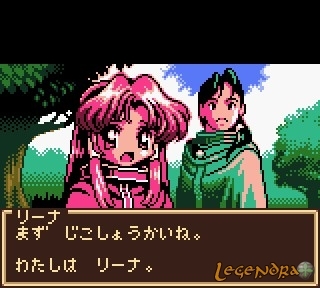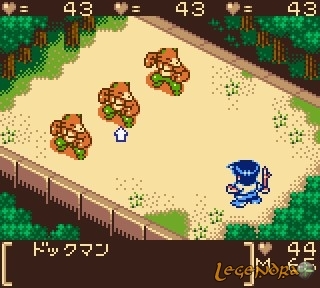|
|

|
PLATFORM
|
GameBoy Color
|
BATTLE SYSTEM
|

|
INTERACTION
|

|
ORIGINALITY
|

|
STORY
|

|
MUSIC & SOUND
|

|
VISUALS
|

|
CHALLENGE
|
Moderate
|
LANGUAGE BARRIER
|
Moderate
|
COMPLETION TIME
|
20-40 Hours
|
|
OVERALL

|
+ Designed to play in short installments.
+ Surprising amount of optional material.
+ Good midi tunes.
- Management menus are awkward.
- Only one character in battles.
+ Hero receives a spanking.
|
Click here for scoring definitions
|
|
|
Last May I managed to find a rechargeable battery pack for my GameBoy Advance in a local used game store. This is notable because accessories for defunct systems can be surprisingly difficult to find in Japan. When they are found, they're often heavily discounted. The charger cost me a dollar. Ironically, the game that it enabled me to play cost ten times that.
Soul Getter is one of those GameBoy Color titles that no one has ever really heard of. It came out in the year 2000, around the time Nintendo was gearing up to the GBA, and like many GBC titles from that year it wasn't localized overseas. In usual Japanese precision, its genre is listed as "After-School Adventure RPG," which as we shall see sort of fits.
This title takes its adventuring roots seriously, and the game is reminescent of earlier fantasy RPG titles, especially the original Dragon Quest. The hero is the sole playable character, with a choice of male or female protagonist (which mainly affects certain armor choices late in the game). For the sake of this review, let's assume that the main character is female and that her name is Elaine. Elaine is a normal village girl. She leaves home at nine o'clock every morning, attends school until noon, and then plays with her friends until dinnertime. That is, until a chance meeting gets her involved in a quest to recover the magical artifacts necessary to prevent to the return of an honest-to-badness Dark Lord. Now, every day after school she searches through ruins, tramps through forests, crosses oceans and braves deserts. In a humorous twist she still has to be home for dinner every evening, and her parents do not discover their offspring's extracurricular activities until late in the game. Then a truly heroic spanking is administered.
The need to return home at regular intervals leaves its mark on Soul Getter's story. At any given time there will be a specific goal, often requiring Elaine to save her traveling companions from some mishap along the way. Once the goal is accomplished, she teleports home for dinner, rests, and saves the game. These events are spaced evenly throughout the game and, along with the quick-save function in dungeons, make Soul Getter easy to play in short bursts.
 The Dark Lord has stolen our noses!
The Dark Lord has stolen our noses!
|
|
The battle system is simple enough -- it's just the hero versus one to three monsters on an isometric battlefield. Some monsters are strongly resistant to physical attacks while others ignore magical attacks as if they were nothing, so the hero can't succeed through repetitive use of brute force alone. This is where the Souls from the game's title come into play. Souls are magic crystals that come in four elemental colors and a variety of tetrisoidal shapes. When plugged into the appropriate spaces in a magic pendant they can enable all sorts of interesting spells.
Most of the basic and mid-range Souls can be won in regular combat against monsters, but for the most powerful ones Elaine must search the various levels of the game thoroughly. In order to use every spell in the game, all of the game's six optional dungeons must be raided, several secret areas found in-town, and finally a few of the most powerful spells must be won off of difficult monsters in the final level. Certain spells can be used outside of battle as well, usually as a means of solving a level's puzzles. Most of these occur in the optional dungeons, but even so it makes for a good change of pace.
With a library of forty-plus spells, the magic menus can get a bit crowded. Spells are added to the menu in the order that their pendants are activated, and there is no automatic sorting function included. In order to organize spells, the player must switch them back and forth one at a time until they are in the desired order. Weak or unnecessary spells can simply be removed, but the layout is still far from optimal.
Souls also play a part in the event of a Game Over. Should Elaine fall in battle, the mysterious thief Yamo will swoop in to save her, but only in exchange for one Soul from an active pendant. This means that a spell may become unusable for some time, if the Soul taken away was one of the rarer varieties. If there are no Souls available for Yamo to take, then it's Game Over for real. This generally happens early in the game when the player's Soul collection is still minimal. Later in the game Yamo can be challenged to win back any Souls the player may have lost to him.
 Bad dog!
Bad dog!
|
|
One last thing that should be mentioned about the battle system is the Tension meter. Every time Elaine gets a hit in, the meter goes up some. Every time she's hit, it goes up by a little. Critical hits make it go up a lot. When the meter goes over one hundred, the player can trigger a "rampage attack" that does damage to everything on screen. More importantly, if the meter hits 255, the rampage goes off automatically, lasts longer, and finishes with a coup-de-grâce magic attack. Timing the appearance of these rampages is a matter of strategic importance, as even the toughest bosses will feel the pain when a hero goes all-out.
Soul Getter features some decent graphics and spritework for its time. The game's five towns are well designed and visually distinct in layout, coloring, and even architectural style, as are most of the dungeons. The monster sprites seen in battle have a little animation to them, and the spell animations get progressively bigger and better over the course of the game. The game stands out musically as well, at least for its time and platform. The various themes for towns, dungeons, and field are all catchy and do not grate on the ears, but in the end they are still GameBoy midi compositions.
As this is a GameBoy Color title, it's not too hard to read. The kanji count is practically zero, with all text in hiragana or katakana, and there is some spacing between words which makes it easier to look things up in the dictionary if necessary. The biggest linguistic hurdle is when an NPC gives specific hints or directions to the more maze-like levels of the game. If the player isn't able to parse through it all correctly, then a lot of trial and error will be necessary to succeed.
For me, Soul Getter has been a good romp through the nostalgia of turn-of-the-millennium gaming. It has also aged surprisingly well as a game. Battles always require some thought, but never too much; the sound is good enough to make me get out my earphones when playing on the train; and it has a surprisingly large amount of optional material to explore in the form of extra dungeons. In my opinion, it was money well spent.
edited 8/17/10 -- forgot to mention the Tension system.
Review Archives
|









